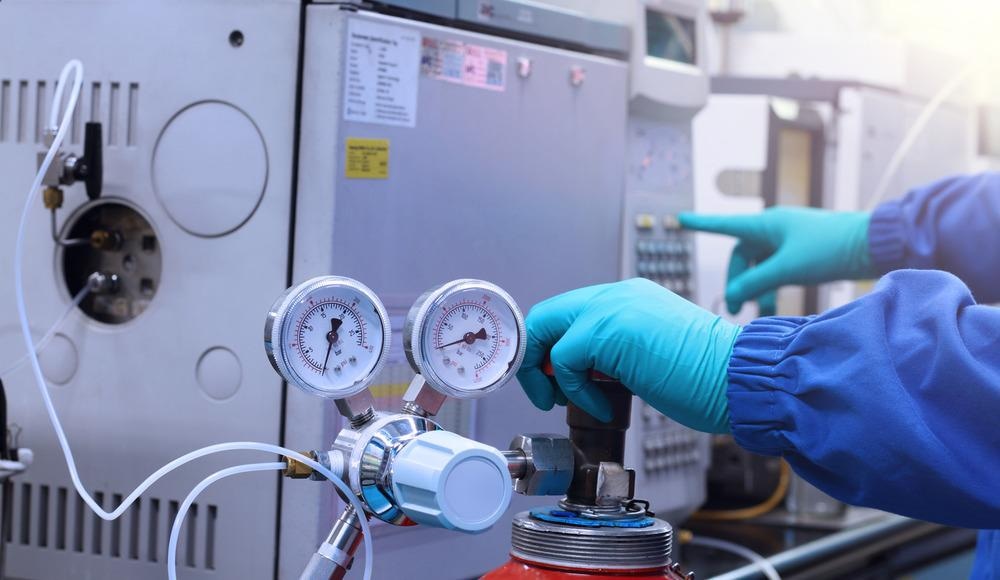Analytical chemists have many tools at their disposal to analyze a chemical compound and one of the techniques commonly used is gas chromatography (GC). This article will discuss the advantages of this analytical technique.

Image Credit: tanewpix168/Shutterstock.com
What is Gas Chromatography?
Gas chromatography is a common chromatography technique used to separate and analyze volatile chemical compounds which do not decompose. It is typically used to separate different compounds within a mixture or test sample purity. The equipment used in a GC experiment is called a gas chromatographer.
In a GC experiment, there are two stages: a mobile and a stationary phase. The mobile phase is also usually called the carrier gas. An inert gas (such as hydrogen, helium, argon, or nitrogen) is used as the carrier gas. The purpose of the carrier gas is to carry any unadsorbed molecules through the column.
The stationary phase is specifically a viscous liquid held on an inert solid support contained within a glass or metal column. In some columns, the solid material is also used as the stationary phase, depending on the needs of the experiment. The entire process is carried out in a temperature-controlled oven. The chemical composition of the resultant eluent is then monitored and analyzed by a detector and software.
Physiochemical properties of the analyte are sensed by the detector. This is amplified and converted into a signal, producing a chromatogram. Most detectors used by GC equipment were specifically developed for the technique, except for thermal conductivity detectors and mass spectrometers. There has been an increased use of GC coupled with mass spectrometry in recent years due to the unique advantages of both techniques.
Advantages of Gas Chromatography
Although the technique does have some limitations, there are clear advantages to using gas chromatography compared to other chromatography techniques. These include:
- Improved Resolution – Closely related peaks in the data can be resolved more easily with GC techniques than with other chromatographic methods such as thin-layer chromatography (TLC.) Parameters can be adjusted in real-time, meaning appearing peaks can be resolved better. GC is suitable for incredibly complex mixtures such as smoke which are almost impossible to resolve with TLC.
- Improved analysis speed – Operational parameters can be easily changed (including during the experiment) meaning that analysis of a sample can be completed in the space of a few minutes. Optimum resolution can be achieved quickly with GC.
- Wider sample choice – A wider choice of volatile samples can be analyzed with GC. The ability to control the temperature of the process allows for samples with high boiling points to be analyzed.
- Fully quantitative – The software used in gas chromatography provides more accurate data than other techniques, making it a fully quantitative technique. TLC, for example, requires extra equipment such as densitometers or treatment steps, increasing the cost of any experiments.
- More sensitive – Specialized detectors can detect target compounds at much lower limits than other techniques, meaning that gas chromatography has a high degree of sensitivity.
- Nondestructive testing capabilities – Detectors used in gas chromatographers, such as flame photometric detectors and thermal conductivity detectors, are nondestructive. This makes GC a technique suitable for nondestructive testing of samples.
- Column choice – Columns available for use in a gas chromatographer have a wide range of sizes, meaning that they can be used for a wide range of applications. GC experiments can also be carried out using different stationery and liquid support phases.
- Software capabilities – GC has a range of improved software capabilities. Increased normalization, peak, and baseline optimization leads to improved real-time control and results reporting. This confers a distinct advantage upon gas chromatography compared to more traditional techniques as increased data analysis capabilities lead to better and improved results.
- Column reuse – The columns used in gas chromatography experiments can be reused, significantly reducing the operational costs of experiments. However, they must be stored properly as per the manufacturer's instructions.
- Storage of results and records – In TLC, the solid plates can degrade over time, meaning that there is a finite shelf-life of results unless they are digitized. Data produced by the software in GC equipment, however, can be stored indefinitely.
In Conclusion
Gas chromatography is a technique that provides several advantages over more traditional techniques such as thin-layer chromatography. One distinct disadvantage of the technique, however, is that it is limited to thermally stable and volatile compounds, making it unsuitable for organic samples such as proteins, peptides, or drug derivatives. Other techniques, such as high-performance liquid chromatography (HPLC) are more suited to the analysis of these types of compounds.
References and Further Reading
Chemistry LibreTexts – 3.1: Principles of Gas Chromatography https://chem.libretexts.org/Bookshelves/Analytical_Chemistry/Book
Dr. Deepak. (2015) Advantages of Gas Chromatography (GC) over Thin Layer Chromatography (TLC) [Online] Lab Training. Available at: https://lab-training.com/2015/09/29/advantages-of-gas-chromatography-gc-over-thin-layer-chromatography-tlc/
Jordan University of Science and Technology. Gas Chromatography [Online] Available at: https://www.just.edu.jo/FacultiesandDepartments/FacultyofScienceandArts/Pages/Gas-Chromatography.aspx
Disclaimer: The views expressed here are those of the author expressed in their private capacity and do not necessarily represent the views of AZoM.com Limited T/A AZoNetwork the owner and operator of this website. This disclaimer forms part of the Terms and conditions of use of this website.